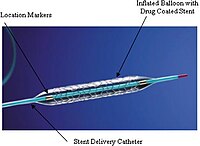
Photo from wikipedia
Abstract Nickel (Ni) and cobalt (Co) release from chromium-alloy powders (different stainless steels and a nickel-based Inconel alloy) compared with Ni and Co metal powders was investigated at simulated human… Click to show full abstract
Abstract Nickel (Ni) and cobalt (Co) release from chromium-alloy powders (different stainless steels and a nickel-based Inconel alloy) compared with Ni and Co metal powders was investigated at simulated human exposure scenarios (ingestion, skin contact, and inhalation) between 2 and 168 h. All investigated powders consisted of particles sized within the respirable range. The powder particles and their surface reactivity were studied by means of nitrogen adsorption and electrochemical, spectroscopic (X-ray photoelectron spectroscopy and atomic absorption spectroscopy), light scattering, and microscopic techniques. The release of both Ni and Co was highest in the acidic and complexing fluids simulating the gastric environment and an inhalation scenario of small powders (artificial lysosomal fluid). Relatively high corrosion resistance and lower levels of released Ni and Co were observed in all fluids for all alloy powders compared with the corresponding pure metals. The extent of released metals was low for powders with a passive surface oxide. This study strongly emphasizes the importance of considering alloying effects in toxicological classification and/or regulation of Ni and Co in alloys and metals.
Journal Title: Annals of Work Exposures and Health
Year Published: 2020
Link to full text (if available)
Share on Social Media: Sign Up to like & get
recommendations!